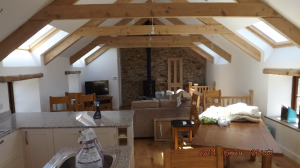- Trevaylor
- Barn near Breage
- Finished barn conversion near Penzance
- Finished barn conversion with solid oak windows
This listed Barn at Grampound Road needs Listed Building Consent
Some have been converted to holiday home and the smaller one demolished and will rebuilt as a new build holiday home. Below is the internal finished building
[wc_row][wc_column size=”one-half” position=”first”]
Up to recently Barn Conversions have needed full Planning Consent. After recent legislation (April 2014) it has become possible for a farmer to convert a barn under a new Permitted Development rule.
But not all is simple there are a number of ‘Ifs and buts’ for example:
-
if it is in an Area of Outstanding Natural Beauty (AONB)
-
if it is a listed building
-
if it isn’t on an agricultural unit (e.g. if the barn is in a garden or paddock rather than on a farm)
So caution is advised before spending sums of money on such a project. Call me for free advice.
More rules :
“There are no current plans beyond the three years and therefore we advise landowners to seize this opportunity now. There is the chance to develop up to 450 square metres, a very sizeable area, of agricultural buildings on a farm to provide a maximum of three houses on that holding.
The new permitted development changes will allow the change of use of an agricultural building to a dwelling house. It allows for changes to floor space of up to 450 square metres per agricultural holding, to up to 3 dwellings.
The changes apply to existing agricultural buildings in a sole agricultural use, in connection with a trade or business, as of March 20, 2013, or if the site is not in use on that date, when it was last in use.
For any new agricultural buildings built or brought into an agricultural use after this date, the building must be in agricultural use for at least 10 years before these permitted changes can be applied.
The changes apply in England only and will not apply in designated areas including National Parks, Areas of Outstanding Natural Beauty and Conservation Areas.
They do not apply if the land forms part of an Area of Special Scientific Interest (SSSi), a safety hazard area or a military explosives area.
The changes do not apply to Listed Buildings, or if the site contains a Scheduled Monument.
The new permitted development rights also allow for physical changes necessary to convert the building to a dwelling house. These are qualified as the installation or replacement of:
-
(i) windows, doors, roofs or exterior walls, or
-
(ii) water, drainage, electricity, gas or other services,
including any partial demolition needed to carry out the above works.
You would not be able to extend the building outside of the footprint of the external dimensions of the existing building.
However the above provision for partial demolition and rebuilding of walls and rooves would suggest it will be possible to rebuild less structurally sound or unattractive newer additions to buildings.
Whilst you will be able to use the curtilage of the building as garden land, the new houses created under these provisions will not benefit from normal residential permitted development rights, for example to extend a property or erect outbuildings such as garages or sheds within those curtilages. Such development will require planning permission.
[/wc_column][wc_column size=”one-half” position=”last”]
There is a prior notification procedure where you must apply to the Council to give them the opportunity to approve of refuse matters relating to
-
Transport and highways impacts – Noise impacts
-
Contamination risks at the site – Flooding risks on the site
-
Whether the location or siting of the building is practical and desirable for a dwelling
-
Design and external appearance
You must submit a prior approval application to the Council.
Application forms will be made available and should be accompanied by a written description of the proposed development, a plan of the site and your contact address and/or email.
The Council is also allowed to ask for further information that it considers necessary, including an assessment of the impacts or risks that may arise from the proposed development and a statement setting out how these impacts or risks are to be mitigated, and details of any physical works you are planning to carry out to enable the development.
The Council have 56 days from the submission of a valid application to issue a decision; if a decision is not issued within this time then development can begin. If the Council refuse your prior notification application you will have a right of appeal.
Once you carry out permitted development to convert your disused agricultural buildings to dwelling houses, you will not be able to erect any new agricultural storage buildings under permitted development rights for a period of 10 years.
Similarly, if you have erected any new agricultural storage buildings under permitted development rights since 20th March 2013 or if you do so in the future, you will not then be able to take advantage of the rights to convert agricultural buildings to residential uses for a period of 10 years.
If you want to convert an agricultural building which is currently, or has in the last year, been part of an agricultural tenancy then you must have the express consent of both the landlord and the tenant that the site is no longer required for agricultural purposes.
The new provisions also allow for the conversion of agricultural buildings up to 500 square metres to a state-funded school or registered nursery, subject to conditions.
Similarly, provisions introduced last year allow agricultural buildings of up to 150 square metres to change into a range of commercial uses including shops, restaurants and cafés, offices, storage and distribution, hotels or assembly and leisure uses, again subject to conditions
[/wc_column][/wc_row]
Links:









